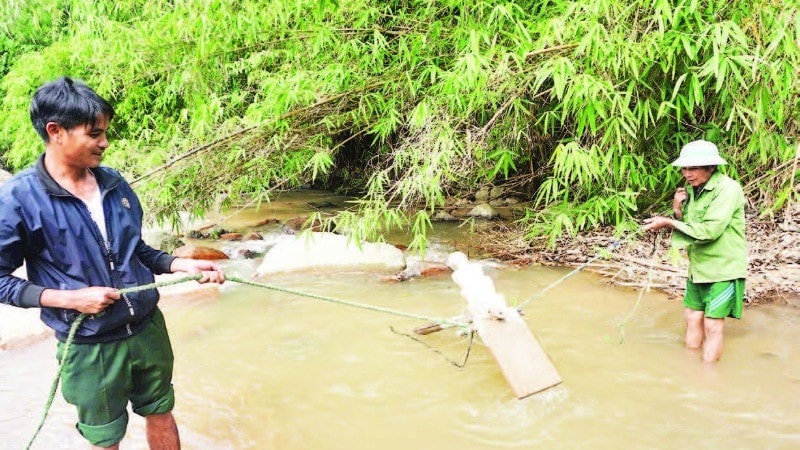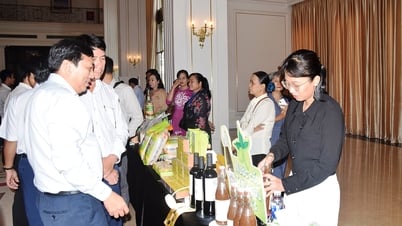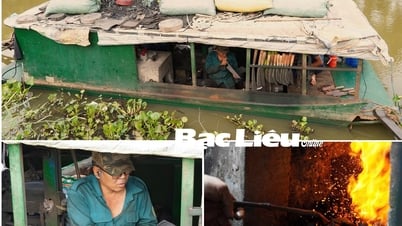To scare away birds and wild animals from destroying rice and crops, many places often make scarecrows or hang colorful objects in the fields. However, the Gie Trieng people in Dak Plo commune, Dak Glei district, Kon Tum province use sounds made from “ca xat”. “Cà xat” or “xèng” is the way the Gie Trieng people call a tool that creates sound from the force of water.
 Village elder A Cho (right) looks for a suitable location to place the new "ca xat".
Village elder A Cho (right) looks for a suitable location to place the new "ca xat".According to village elder A Cho in Bung Ton village, Dak Plo commune, since ancient times, the Gie Trieng people have considered rice as the main food crop of their people. From rice, people have delicious, soft and fatty rice grains, feeding many generations of Gie Trieng people on this land. Cherishing rice grains, the Gie Trieng people always use every way to protect their rice fields and crops. Especially for Dak Plo, a border commune, bordering mountains and forests, people's rice fields are often disturbed by birds and wild animals. Therefore, previous generations created the "ca sat" to protect rice plants and rice grains from being eaten and destroyed by birds and wild animals. The main part of the "ca sat" is a rectangular board about 1 meter long, carved with a large bottom and a gradually smaller top. A wooden stick is inserted through the middle of the board called the tail, to keep the board balanced against the force of the water. Then, use a rope to tie the board horizontally at both ends to catch the water force. Specifically: one end will be tied to a tree trunk or wooden stake, the other end of the rope will be tied directly to a flexible piece of wood. This piece of wood will vibrate the rope when the force of the water acts on it and this rope system will directly pull the bamboo tubes to move and release to create sound. When making "ca sat", people often choose solid, waterproof wood such as chestnut, oak... cut into boards. The rope tying the board to the "bell" is a forest rope woven together to limit breakage and rot due to the impact of the weather. The most important step is making the "bells". The Gie Trieng people find fresh, straight bamboo trees, then split the bamboo in half lengthwise until about halfway up the tree trunk and stop. People will drill a hole in the split side and then tie a piece of string from a flexible tree to the “ca sat” and it will be completed. Although it sounds simple, according to the experience of village elder A Cho, from choosing the bamboo tree to the steps to complete the “bell”, the maker needs to be attentive and careful. Because if there is just one small mistake, the “bell” may not ring or the sound will not resonate as usual.
After completion, choosing a location to place the “cà xoat” is also extremely important, it must catch the flow of water, and it must be hidden behind a rock so that it is not damaged by trees flowing down from the source. After determining the location, each person will use one end to string and secure the new “cà xoat”. Once the “cà xoat” has been stretched out in the middle of the stream, catching the rushing water, the next step is to connect the “bells”. The bundle of strings connected to the “cà xoat” will be divided into many spider web-like connections to tie to different “bells”. The more “bells”, the louder, more even and resonant the sound will be. Depending on the conditions, some families will leave the “cà xoat” in the field all year round, but some families will bring it back to the rice barn to preserve and use it when the rice blooms (June of the solar calendar). Therefore, for the Gie Trieng people, the sound of the “bell” coming from the “ca sat” is the signal for the harvest season. The more “bells” a family has, the more fields they will have.
Nowadays, although production and life have changed a lot, the Gie Trieng people’s fields still have the sound of “bells” ringing in the wind, blending with the rhythm of water on the “ca sat” (wheels). Wherever the Gie Trieng people in Dak Plo commune go, the familiar, cheerful sound emitted from the “ca sat” in the fields still follows them through the years.
Source: https://baodaknong.vn/doc-dao-ca-xat-tren-dong-ruong-nguoi-gie-trieng-250396.html


![[Photo] Prime Minister Pham Minh Chinh attends the groundbreaking ceremony of Trump International Hung Yen Project](https://vphoto.vietnam.vn/thumb/1200x675/vietnam/resource/IMAGE/2025/5/21/ca84b87a74da4cddb2992a86966284cf)
![[Photo] Scientific workshop "Building a socialist model associated with socialist people in Hai Phong city in the period of 2025-2030 and the following years"](https://vphoto.vietnam.vn/thumb/1200x675/vietnam/resource/IMAGE/2025/5/21/5098e06c813243b1bf5670f9dc20ad0a)
![[Photo] Prime Minister Pham Minh Chinh receives Rabbi Yoav Ben Tzur, Israeli Minister of Labor](https://vphoto.vietnam.vn/thumb/1200x675/vietnam/resource/IMAGE/2025/5/21/511bf6664512413ca5a275cbf3fb2f65)


![[Photo] Determining the pairs in the team semi-finals of the National Table Tennis Championship of Nhan Dan Newspaper](https://vphoto.vietnam.vn/thumb/1200x675/vietnam/resource/IMAGE/2025/5/21/eacbf7ae6a59497e9ae5da8e63d227bf)





















































































Comment (0)